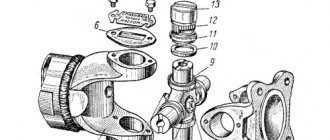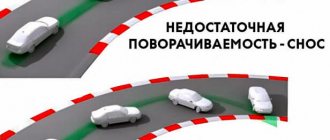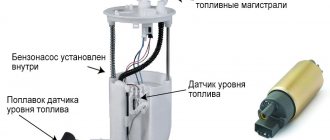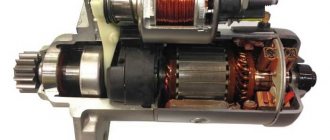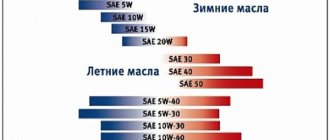Many novice car enthusiasts and those who are just undergoing training before passing the exam at a driving school very often do not know what such parameters as “gross vehicle weight” and “maximum permissible vehicle weight” mean. Some people believe that these definitions are equal and have the same meaning, while others are simply confused about their parameters. But knowing what each of these definitions means, and what its meaning should be for a specific brand of car, is simply necessary! Otherwise, you can inadvertently violate traffic rules and cause mechanical damage to the car.
Maximum vehicle weight with trailer
The maximum weight of a vehicle with a trailer is limited by law.
Before considering the standards provided for in current laws, we should dwell on what exactly the weight of a vehicle is. The term “curb weight” refers to the weight of an unloaded car with a full tank of fuel and the driver inside. This takes into account the weight of the average driver, which is 75 kilograms.
The term “maximum load” usually means the maximum permissible weight of cargo that a car can carry. This data is indicated in the registration documents. To calculate the total weight, the curb weight must be added to the maximum load. The term “gross weight” refers to the actual weight of the vehicle at the current time.
Load capacity
Motorists and experts believe that during vehicle operation, a more significant indicator than the curb weight is the carrying capacity. This is what drivers and specialists involved in road transport usually operate with.
Load capacity is the weight that a vehicle is designed to carry. It matches the specifications. The machine must not carry loads exceeding the specified maximum.
The second name for a car's carrying capacity is payload mass (MPM). But in life, they usually use the first option, since it is more accessible to understanding and remembering.
MPN is divided into:
- Calculated. Only the maximum weight that the car is designed for is taken into account.
- Nominal. The quality of the roads along which the cargo is transported is taken into account.
The Importance of Compliance with Weight Limits
KAMAZ-5320 is an onboard tractor, the chassis of which is structurally designed for towing a trailer in order to increase load capacity. To comply with safety rules when transporting goods, as well as to increase the service life of components and assemblies, the manufacturer determines the overall weight characteristics of the vehicle. The parameters given in the technical and service documentation make it possible to eliminate vehicle overload and equipment breakdown, as well as the creation of an emergency situation on the road.
Exceeding the machine's load capacity given in the official documentation can lead to negative consequences:
- Violation of operating rules.
- Failure of equipment, components and assemblies.
- Idle car in a car service center.
- Additional maintenance costs.
- Failure to order cargo transportation.
- Hefty fines, etc.
The onboard tractor is designed to safely transport 8 tons of cargo in the body, as well as an additional 8 tons in the trailer. The body, which is a loading platform made of durable metal, is equipped with opening sides. It is installed and fixed on a durable chassis. Thanks to the versatility of the loading platform, unloading can be done from any side. The sides of the body are designed for installation of an awning, which provides the ability to transport cargo in any weather. Due to maintainability, availability of spare parts and ease of maintenance, freight transport is in demand in industries, as well as in companies engaged in cargo transportation in agriculture and commerce.
How does curb weight differ from gross weight?
The concept of “permissible gross vehicle weight” means the maximum loaded vehicle weight provided by the manufacturer. It is also sometimes called the maximum permitted or maximum permissible. By subtracting the curb weight from the total vehicle weight, you can find out the vehicle's carrying capacity. Accordingly, the total weight of the vehicle is always greater than the curb weight and, even more so, greater than the dry weight.
All elements of the car are calculated and then manufactured with a certain margin of safety. Everyone knows that exceeding the vehicle load significantly impairs braking efficiency and traction characteristics, and also directly affects safety.
Maximum vehicle weight with trailer
The maximum permissible weight of trucks and trailers is regulated by laws and regulations. According to the law, a truck can tow any trailer. At the same time, the maximum permissible weight of a car with a trailer is affected by the category and design of the vehicle.
Maximum total weight:
- 2-axle vehicles with a trailer - no more than 18 tons;
- 3-axle - no more than 24 tons;
- 3-axle with a drive axle having two pairs of wheels - up to 25 tons.
If you are going to use a trailer for transportation, then the load must be distributed so that the maximum pressure on the tow bar (a towing device designed for towing trailers) is 60–80 kg.
If you exceed this norm, there may be a problem with the traction of the front wheels. If it is not up to standard, problems will arise with the rear wheels.
Indicators of permissible vehicle weights have important practical significance. Almost all of them have duplicate terminology that drivers use. In order not to get confused in terminology and numbers and not get into a problematic situation on the road, before operation it is useful to familiarize yourself with all the technical characteristics of the car, including weight indicators.
Statistical and dynamic weighing
At special points located on the highway, control weighing takes place in order to determine whether the car is overloaded and what the axle load is.
Weigh it in two ways:
- in statics;
- in dynamics.
Both of these methods are used today, let’s find out what their differences are. So, static weighing occurs like this: a car drives onto the scales and stops. This method determines the exact weight of the vehicle at the moment.
Dynamic weighing occurs when the vehicle is moving slowly. This method is necessary to determine the load on each axle. The car moves on the scale at a speed not exceeding 5 km/h.
The only disadvantage of this method is the error, which you definitely need to be aware of. The maximum can be 3%.
All scales used today at weighing points are predominantly electronic. Entry to them is made using a ramp. It is not always the case that two types of scales are installed at the same post.
What is the curb weight of the car
The curb weight of the vehicle is the total, i.e. the total weight of the vehicle with a set of standard equipment, all its operational consumables that are necessary (for example, coolant and engine oil), a fully filled tank with automobile fuel, the weight of the driver, but without the weight of cargo and the weight of passengers.
Ukrainian Caravaners Club
Is it possible to pull a caravan with a small and light car?
Post by sonkotra » Thu Jul 07, 2021 10:53
Re: Is it possible to tow in a passenger car?
Post by Oldmen » Thu Jul 07, 2021 13:25
Re: Is it possible to tow in a passenger car?
Post by Co-pilot » Thu Jul 07, 2021 14:09
Is it possible to pull a caravan with a small and light car?
Post by Artemon » Thu Jul 07, 2021 15:32
Re: Is it possible to tow in a passenger car?
Post by valera krm » Thu Jul 07, 2016 16:45
Why! In the car's passport (if my memory serves me correctly) they write that a trailer equipped with brakes is allowed up to 1300 kg
Added after 38 seconds:
Post by Artemon » Thu Jul 07, 2021 17:31
I think it will be useful
WHO IS ALLOWED TO TOW TRAILERS Requirements for the level of training of the driver of a road train consisting of a passenger car-tractor and a trailer are determined by the current Rules of the Road and other regulatory documentation on ensuring safety in road transport. “If the permitted maximum weight of the trailer does not exceed the weight of a curb vehicle belonging to category “B”, and also the permitted maximum weight of the coupled combination of vehicles does not exceed 3,500 kilograms, a driver’s license with a permit is sufficient when driving them. Drivers who have the right to drive vehicles of categories “B”, “C” or “D” can also drive them with a trailer, the maximum permitted weight of which does not exceed 750 kilograms. Drivers of vehicles of categories “B”, “C” and “D” when towing trailers with a gross weight of more than 750 kg must have a permit on their driver’s license. Below is a summary of the contents of the provisions on towing trailers from the UN Convention on Road Traffic and from the Road Traffic Regulations of some European countries. The permitted maximum weight of a trailer not equipped with a service brake must not exceed half the sum of the unladen weight of the towing vehicle and the weight of the driver. Half of the curb weight of the car is determined by the passport data, the driver’s weight is taken to be 75 kg. With a Category B driver's license you can tow a light or heavy trailer under the following conditions. If twice the maximum weight of a light unbraked trailer does not exceed by more than 75 kg the curb weight of the vehicle used as the towing vehicle. Example: Curb weight of the towing vehicle: 1450 kg Weight of the loaded trailer: 740 kg Permitted maximum weight of the trailer: 750 kg Twice the actual weight of the trailer (740 kg x2) is less than 1450 kg + 75 kg A light trailer with an inertia braking system can be towed, if the actual gross weight of the trailer does not exceed the permissible maximum weight of the vehicle used as a towing vehicle. If the vehicle's passport indicates the permitted maximum weight of the towed trailer, you should be guided by this value. Example: Loaded car - 700 kg, loaded trailer - 700 kg. The trailer is no heavier than the car. Towing a heavy trailer is permitted if the permitted maximum weight of the loaded trailer is less than the curb weight of the towing vehicle without load, and the total permitted maximum weight of the tractor and loaded trailer does not exceed 3500 kg. If the vehicle's passport indicates the permitted maximum weight of the towed trailer, you should be guided by this value. Example: Permissible gross weight of the tractor: 1700 kg Curb weight of the tractor: 1200 kg. Gross weight of the trailer with cargo: 1000 kg Permissible gross weight of the trailer: 1150 kg 1150 kg not more than 1200 kg 1700 kg + 1150 kg less than 3500 kg If the permissible maximum weight of the loaded vehicle and trailer exceeds 3500 kg, towing is permitted only to drivers with a driver's license certificate of category “B” + “E” and, accordingly, “C” + “E”. If you have a driver’s license of category “B” + “E”, then the following matters: if the trailer has only an inertial braking system, then the permitted maximum weight of the loaded trailer must not exceed the curb weight of the tractor; if the vehicle manufacturer allows this vehicle to tow heavy trailers. If the vehicle's passport indicates the permitted maximum weight of the towed trailer, you should be guided by this value.
Permissible vehicle weight
five-axis and more
Road trains, saddle and trailed
six-axis and more
If a vehicle (laden or unladen) exceeds the above permissible maximum vehicle weight, such a vehicle is classified as heavy.
Further operation of such a vehicle on public roads of the Russian Federation is possible only with a special permit.
A special permit for the movement of a vehicle transporting heavy cargo on public roads is issued by the Federal Road Agency “Rosavtodor” and its subordinate institutions.
Since 2012, it has been possible to submit applications for special permits electronically through the Unified Portal of State and Municipal Services, located on the Internet at www.gosuslugi.ru.
A special permit is issued for one trip or for several trips (no more than ten) of a vehicle along a specific route with similar cargo having the same characteristics (name, dimensions, weight).
A special permit is issued for a period of up to three months.
The route of movement of a vehicle exceeding the permitted maximum weight is agreed upon with the owners of the roads and the State Road Safety Inspectorate.
For issuing one special permit for the movement of a heavy vehicle, a state fee of 1,600 rubles is required.
For driving a vehicle exceeding the maximum permissible weight on public roads, a fee is also provided to compensate for damage caused to roads.
The amount of the fee is calculated for each application individually when issuing a special permit in accordance with the methodology and provisions of the Decree of the Government of the Russian Federation of November 16, 2009 No. 934 “On compensation for damage caused by vehicles transporting heavy cargo on the roads of the Russian Federation.”
Responsibility for violating the rules of movement of a heavy vehicle is provided for in Article 12.21.1 of the Code of Administrative Offenses of the Russian Federation.
Responsibility for exceeding the maximum permissible weight of a vehicle lies with all persons guilty of committing this offense: the driver, officials responsible for transportation, an individual entrepreneur or a legal entity.
If an administrative offense is recorded by special technical means operating automatically and having the functions of photography, filming, and video recording, an administrative fine is imposed on the owner (possessor) of the vehicle.
Depending on the amount of excess of the permissible maximum weight of the vehicle, measured as a percentage, the amount of liability of the perpetrators also changes.
The greater the excess of the permitted maximum weight of the vehicle, the greater the fine imposed on the perpetrators.
Fine for exceeding the permissible maximum vehicle weight
Source: proekt-007.ru
What's the result?
As you can see, the concept of vehicle mass may differ. It is important to understand exactly what weight of the car we are talking about in each specific case (curb, gross, permitted, dry weight, calculated, nominal, etc.). At the same time, the above information allows you to better understand this issue, which in certain situations eliminates common mistakes.
This data makes it possible to increase safety when transporting passengers and cargo, and it is also possible to more accurately understand how much cargo can be transported in a particular car, adjusted for the characteristics declared by the car manufacturer in terms of carrying capacity. In turn, this will allow you to avoid accidentally overloading the car and premature breakdowns or severe wear and tear on the components and assemblies of the vehicle.
Ground is the plus or minus on the battery
When removing the battery from a car, what is the order in which the terminals are removed?
Which terminal should you put on the battery first when installing it?
Should the plus or minus wire be put on and removed first from the battery?
The reason for this strong opinion among car enthusiasts is which terminal should be removed/installed first, solely to prevent the harmful consequences of careless installation/disassembly.
To begin with, an educational program on the topic “what is what” so that by following our advice you can distinguish one from the other. Any rechargeable battery has banks connected in series, which are connected to two outer contacts - the “+” terminal is usually indicated in red or orange and has a thicker truncated cone, and the “-” terminal is indicated in blue or black and has a slightly thinner cone. The downside is “ground” - the contact is constantly closed to the car body. Plus it always breaks with the keys of the electrical circuit.
Battery installation (installation)
When installing the battery, the “+” terminal is put on first; the “-” terminal is put on last. And the point here is not even in the recommendations of the manufacturers, but in eliminating possible accidental short circuits with a metal object to the “+” terminal and parts of the car body. If this happens when the “-” terminal is not yet connected, there will be no short circuit. But when you installed the minus terminal first and began to install the plus, when tightening the latter, it’s not surprising to break the wrench on the body.
Dismantling the battery (removal)
If you are removing a battery, the first step is to loosen and remove the wire from the negative terminal. Because the “minus” is already connected to the car body and is “ground.” If you short-circuit the minus key to the body, nothing will happen (there is no short circuit between the same potential). After you have removed the first minus, you have removed the minus and from the car body, now you can unscrew the positive terminal, and even if you touch the plus and parts of the body, there will be no short circuit either, because the body no longer has a second contact.
No matter how careful you are, I would advise you to remember this rule, because there are situations when you have to install the battery in very cramped conditions, in poor lighting, and even in the dark to the touch. This is where it will come in handy for you. The last one is always “minus”, whether during removal or installation - accordingly, removal began with a minus and the installation ended with a minus.
Hi all. As usual, let's start from afar first. This entry does not pretend to be a guide to action, some kind of manual or anything like that. Perhaps somewhere there is already something similar and more than one, but I have not come across it, and this entry is based on observations, trial and error from personal and other people’s experience.
It's about mass
. Well, that’s just about those cases when they say “check the ground” or “your ground is connected in the wrong place”, “clean the ground terminal”, etc. All these conversations have a completely valid basis. The recording will not describe the entire essence of the issue, but most of it will be about active losses and interference on connections. (there will be no talk about emissions from inductive loads, about the “plus” side of the issue, etc. Which is also important, but in the general form described below is quite consistent).
Ohm's law is to blame for everything, well, that is, not the fault, but the main reason describing this whole matter will be Ohm's law. For those who don’t remember or don’t know, it says (again in one of the formulations) that the voltage drop across a section of the circuit whose resistance is R, and with a current I flowing through this resistance ®, is equal to the product of the current I and the resistance R. That is, U =IxR. For example, at a resistance of 1 Ohm with a current of 12 Amps flowing through this resistance, the voltage drop (it can even be measured with a voltmeter if you connect one voltmeter probe to one contact of the resistor and the second probe to the other contact of the resistor), the voltage drop will be 1 × 12 = 12 Volts. It's simple. R this can be some area where current flows, some kind of load, for example a light bulb connected with one contact to “+”, and the second to “-”, this is also R. And if you put an ammeter in the gap, then measure the current and know that the battery to which the light bulb is connected is 12 volts. Then you can find the resistance of the light bulb)

